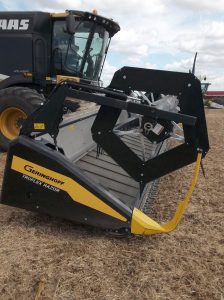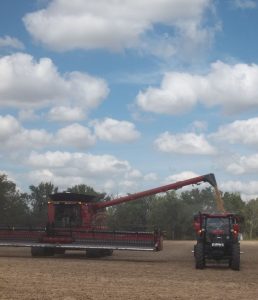Agronomy, Homepage Slider, Soybean Quality
Harvest Technology Preparation
By Dusty Sonnenberg, CCA, Ohio Field Leader: a project of the Ohio Soybean Council and soybean checkoff.
As harvest season 2020 is just getting underway across the state, Dr. John Fulton, Professor and Extension Specialist in Ohio State’s Food Agricultural and Biological Engineering Department says that getting all the technology checked out before going to the field will make processing harvest data easier this winter.

Good data collection is necessary for making informed management decisions in the future. “When we think about yield monitors, and the data they collect, the first step each fall is to make sure the data on the display from previous seasons has been retrieved, and archived or backed-up to ensure nothing is lost,” said Fulton. “We encourage farmers to move it from the thumb drive or card used to retrieve it and stored on a laptop or a hard drive or storage space to make sure it is securely stored.”
Most of the technology used to record yield data and mapping is dependent on the quality of the GPS signal. Older yield monitors use the free WAAS GPS signal, however farmers that utilize the GPS for autosteer and other applications often have a subscription signal such as GNSS which tracks more satellites. “If you are using a correction service for you GPS, make sure you are paid-up before harvest,” said Fulton. “It is also important to make sure that the GPS receiver and yield monitor are up to date and have the latest firmware.”
Other settings and components need to be considered, in addition to the typical bearings, belts and bushings, that are checked and serviced prior to harvest. “We will not get good yield data if the machine is not functioning properly,” said Fulton. “I would recommend thoroughly going through the corn head.  The platform headers today also need close inspection to make sure all the components are functioning properly. Inside the combine, the augers and threshing mechanisms should be checked. The clean grain elevator chain and paddles, along with the bearings on the top and bottom are an important component to yield monitor. The tension needs to be right in order to have the proper setting as it sends clean grain to the impact plate.”
The platform headers today also need close inspection to make sure all the components are functioning properly. Inside the combine, the augers and threshing mechanisms should be checked. The clean grain elevator chain and paddles, along with the bearings on the top and bottom are an important component to yield monitor. The tension needs to be right in order to have the proper setting as it sends clean grain to the impact plate.”
Collecting quality yield data requires quality calibration. “The calibration often refers to calibrating the temperature mechanism in the grain moisture sensor. That is very important,” said Fulton. “The grain moisture sensor itself requires a physical check.”
Estimating yield is a function of the mass flow of the grain. “Calibrating the mass flow sensor, and the response of the sensor is not linear in nature,” said Fulton. “To properly calibrate the combine, a farmer needs to operate in both low flow conditions and high flow conditions, (low yield and high yield), to get a proper calibration. The sensor needs to map out the response in low, medium and high flow, three to four times across the field during calibration, in order to accurately estimate the yield (mass flow estimate).” This will vary as the flow changes across the field in different yield environments, especially in fields with variability due to the weather this year.
Combines should be re-calibrated occasionally during the harvest season, and when changing between crops. “In corn, as moisture changes significantly, there should be separate calibrations. A high moisture corn calibration vs. a calibration for corn below 20% moisture would be a good place to start,” said Fulton. In soybeans a separate calibration should be performed. “In soybeans farmers do not see the same moisture fluctuation, so one calibration curve should be sufficient.”
Harvest loss due to variable crop conditions are also important to monitor. “New combines have a lot of technology to give the operator a lot of information on the harvest loss, and in many cases adjust on the go to reduce harvest loss,” said Fulton. “It is important to get out of the combine and check behind the header to see if the loss is due to the header, or from inside the machine.  Counting the grain on the ground behind the header versus behind the machine will tell where the loss is occurring. On newer machines a loss of 1-1.5% is not uncommon. A loss of 2-3% or more needs an adjustment made.”
Counting the grain on the ground behind the header versus behind the machine will tell where the loss is occurring. On newer machines a loss of 1-1.5% is not uncommon. A loss of 2-3% or more needs an adjustment made.”
Fulton’s also encourages making notes based on observations from the combine cab. “A lot can be observed during harvest,” said Fulton. “Many monitors will allow for pins to be dropped and notes to be made on the go during harvest. Trying to determine what caused yield limitations based on the harvest observations combined with yield maps, planting maps, and in-season aerial imagery are all useful.”